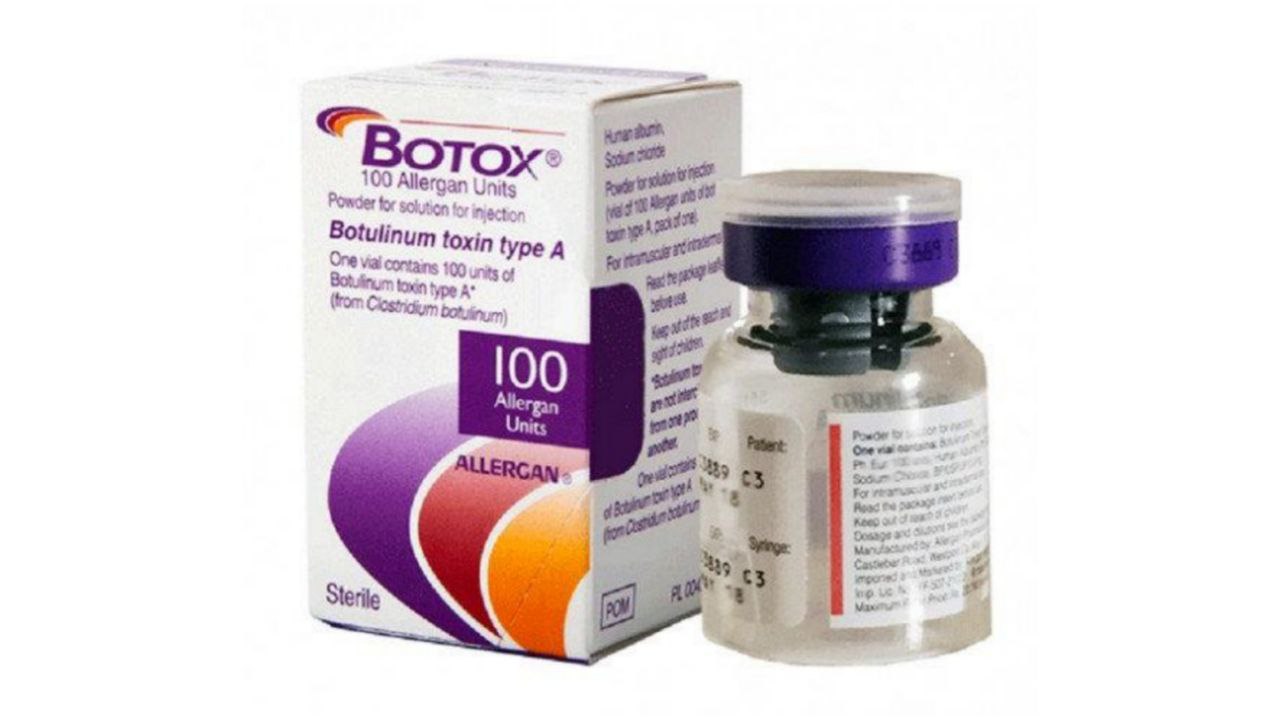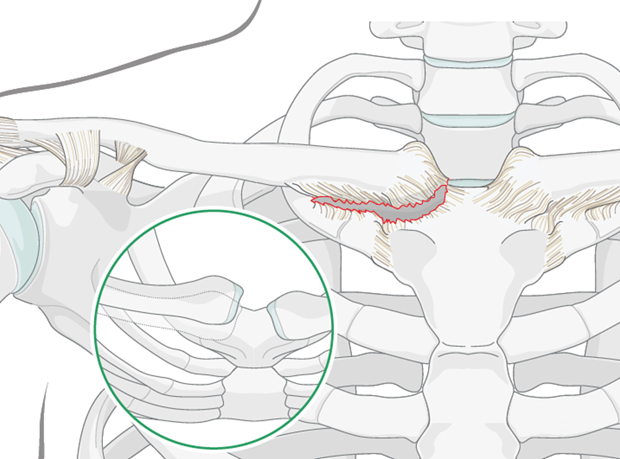
Sternoclavicular Joint Injuries
By : Yaser MohammedIntroduction
Sternoclavicular joint injuries are symptomatic disorders of the SC joint that are relatively uncommon and are less than 5% of shoulder girdle injuries.
SC joint dysfunction can be classified into two categories depending on the mechanism of injury: traumatic or atraumatic.
Note: Traumatic injury is a term that refers to physical injuries of sudden onset and severity which require immediate medical attention. (such as car accidents and sports injuries).
While Atraumatic injuries or instability is when the shoulder starts to slip part way out of the joint without having had a significant injury. This instability may arise from a variety of causes.
SC joint dysfunction can be classified into two categories depending on the mechanism of injury: traumatic or atraumatic.
Note: Traumatic injury is a term that refers to physical injuries of sudden onset and severity which require immediate medical attention. (such as car accidents and sports injuries).
While Atraumatic injuries or instability is when the shoulder starts to slip part way out of the joint without having had a significant injury. This instability may arise from a variety of causes.
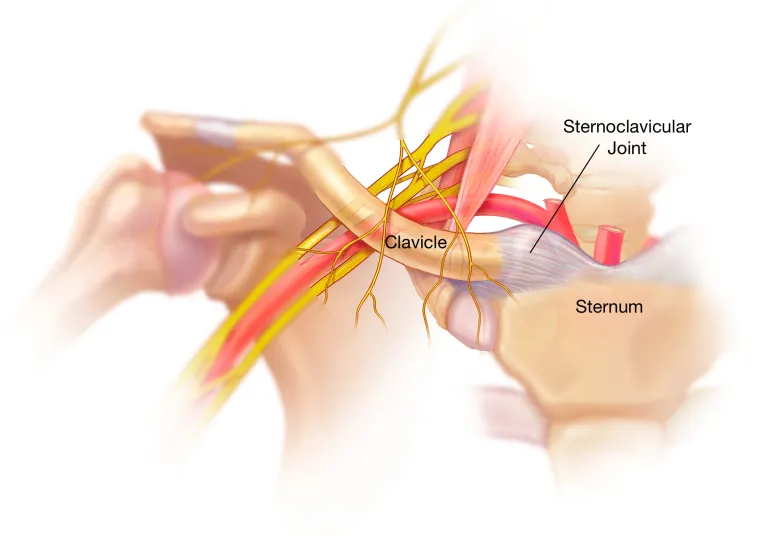
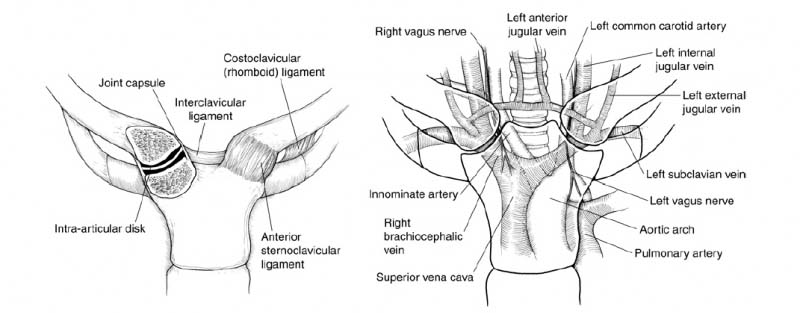
Sternoclavicular Joint Relation
Traumatic Injuries
Traumatic injuries of the SC joint range from minor subluxation to complete dislocations. But its rare in all cases . The rarity of dislocation of the SC joint depends on its strength, which depends on its ligaments, its disc, and the way forces are generally transmitted along the clavicle. Most dislocations
of the SC joint in persons < 25 years of age because of the uncompleted ossification of clavicle at the sternal end before this age.
Typically, this case of injuries occurs due to falls, some sports, and accidents. Anterior SC joint dislocations are more common than posterior dislocation (by a 9:1 ratio ). Posterior dislocations can cause clinical implications as the surrounding nerves and vessels may be damaged.
of the SC joint in persons < 25 years of age because of the uncompleted ossification of clavicle at the sternal end before this age.
Typically, this case of injuries occurs due to falls, some sports, and accidents. Anterior SC joint dislocations are more common than posterior dislocation (by a 9:1 ratio ). Posterior dislocations can cause clinical implications as the surrounding nerves and vessels may be damaged.

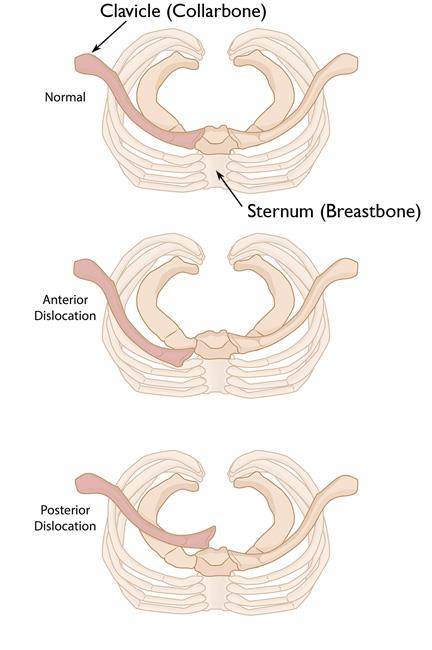
SC joint dislocation
So sternoclavicular joint dislocations or injuries can be classified into three degrees:
First-degree injury: is the most common type of injury in the joint, that causes a simple sprain, which involves an incomplete tear or stretching of the sternoclavicular and costoclavicular ligaments.
Second-degree injury: a complete breach of the sternoclavicular ligament or only a partial rupture in the costoclavicular ligament due to clavicle subluxation (partial dislocation)either anteriorly or posteriorly from its manubrial attachment.
Third-degree injury: complete dislocation of the clavicle from the manubrium due to complete rupture of the sternoclavicular and costoclavicular ligaments.
First-degree injury: is the most common type of injury in the joint, that causes a simple sprain, which involves an incomplete tear or stretching of the sternoclavicular and costoclavicular ligaments.
Second-degree injury: a complete breach of the sternoclavicular ligament or only a partial rupture in the costoclavicular ligament due to clavicle subluxation (partial dislocation)either anteriorly or posteriorly from its manubrial attachment.
Third-degree injury: complete dislocation of the clavicle from the manubrium due to complete rupture of the sternoclavicular and costoclavicular ligaments.
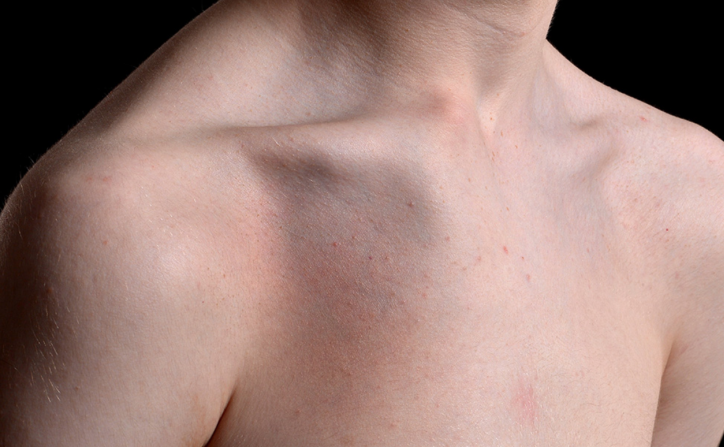
Surface anatomy, SC joint anterior dislocation
Atraumatic Injuries
The SC joint is vulnerable to the same disease processes that occur in joints such as degenerative arthritis, rheumatoid arthritis, infections, and spontaneous subluxation of the joint.
The sternoclavicular joint disorder can result from abnormal motion of the scapulothoracic joint and abnormal scapular motion.
The sternoclavicular joint disorder can result from abnormal motion of the scapulothoracic joint and abnormal scapular motion.
Ankylosis of SC Joint
What is Ankylosis? Ankylosis, in medicine, is the stiffness of a joint as the result of injury or disease. The rigidity may be complete or partial and may be due to inflammation of the tendinous or muscular structures outside the joint or of the tissues of the joint itself
Movement at the SC joint is critical to the movement of the shoulder. When ankylosis of the joint occurs or is necessary surgically, a section of the center of the clavicle is removed, creating a pseudojoint or “flail” joint to permit scapular movement.
Movement at the SC joint is critical to the movement of the shoulder. When ankylosis of the joint occurs or is necessary surgically, a section of the center of the clavicle is removed, creating a pseudojoint or “flail” joint to permit scapular movement.
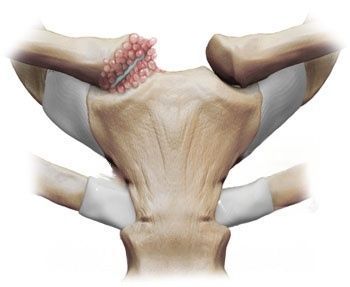
Sternoclavicular joint arthritis
References
1) Moore K. L., Dalley, A. F., & Agur, A. M. R. (2014)- Clinically Oriented Anatomy 7th Edition (813)
2) Sternoclavicular Joint Disorders, Physiopedia.
https://www.physio-pedia.com/Sternoclavicular_Joint_Disorders
3) Sternoclavicular (SC) Joint Disorders, Orthoimfo.
https://orthoinfo.aaos.org/en/diseases--conditions/sternoclavicular-sc-joint-disorders/
4) Sternoclavicular Joint Problems, Eorthropd.com.
https://eorthopod.com/sternoclavicular-joint-problems/
2) Sternoclavicular Joint Disorders, Physiopedia.
https://www.physio-pedia.com/Sternoclavicular_Joint_Disorders
3) Sternoclavicular (SC) Joint Disorders, Orthoimfo.
https://orthoinfo.aaos.org/en/diseases--conditions/sternoclavicular-sc-joint-disorders/
4) Sternoclavicular Joint Problems, Eorthropd.com.
https://eorthopod.com/sternoclavicular-joint-problems/
References of images
Cover image: Posterior sternoclavicular dislocation (https://surgeryreference.aofoundation.org/orthopedic-trauma/adult-trauma/clavicle/medial-extraarticular/reduction-of-sternoclavicular-dislocation)
fig 1: The sternoclavicular joint is in close proximity to vital structures, in particular some pretty big blood vessels, Shoulder & Elbow.
https://i0.wp.com/shoulderelbow.org/wp-content/uploads/2018/04/The-sternoclavicular-joint.jpg?resize=768%2C536&ssl=1
fig 2: Resection Arthroplasty, Sternoclavicular Joint , 23:12, 17 March 2011.
Problemshttps://eorthopod.com/sites/default/files/images/shoulder_stclav_surgery01.jpg. Orthopod.com
fig 3: Sternoclavicular joint and dislocation. (photo from MDguidelines.com)
fig 4: Anterior and posterior dislocation of SC joint, Orthoinfo.
https://orthoinfo.aaos.org/globalassets/figures/a00653f02.jpg
fig 5: Emergency Medicine Education Sternoclavicular Dislocation: ED Presentation, Evaluation, and Management - emDOCs.net.
https://encrypted-tbn0.gstatic.com/images?q=tbn:ANd9GcTmiZHIOL6so4gTZRF8rqqeG-Q4LCc-IGau1w&usqp=CAU
fig 6: Sternoclavicular joint arthritis , shoulderdoc.co.uk.
http://www.shoulderdoc.co.uk/images/uploaded/scjarthritis.jpg
fig 1: The sternoclavicular joint is in close proximity to vital structures, in particular some pretty big blood vessels, Shoulder & Elbow.
https://i0.wp.com/shoulderelbow.org/wp-content/uploads/2018/04/The-sternoclavicular-joint.jpg?resize=768%2C536&ssl=1
fig 2: Resection Arthroplasty, Sternoclavicular Joint , 23:12, 17 March 2011.
Problemshttps://eorthopod.com/sites/default/files/images/shoulder_stclav_surgery01.jpg. Orthopod.com
fig 3: Sternoclavicular joint and dislocation. (photo from MDguidelines.com)
fig 4: Anterior and posterior dislocation of SC joint, Orthoinfo.
https://orthoinfo.aaos.org/globalassets/figures/a00653f02.jpg
fig 5: Emergency Medicine Education Sternoclavicular Dislocation: ED Presentation, Evaluation, and Management - emDOCs.net.
https://encrypted-tbn0.gstatic.com/images?q=tbn:ANd9GcTmiZHIOL6so4gTZRF8rqqeG-Q4LCc-IGau1w&usqp=CAU
fig 6: Sternoclavicular joint arthritis , shoulderdoc.co.uk.
http://www.shoulderdoc.co.uk/images/uploaded/scjarthritis.jpg
